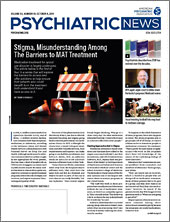A comprehensive behavioral modification strategy that includes parental training, positive incentives, and limit setting (like “timeouts”) to change problem behaviors is more effective than verbal de-escalation for managing agitation in children with disorders like attention-deficit/hyperactivity disorder (ADHD) or oppositional defiant disorder (ODD). The findings were reported in the Journal of the American Academy of Child & Adolescent Psychiatry.
When staff at Stony Brook University Hospital’s 10-bed children’s psychiatric inpatient unit treated agitated children with behavioral modification, they prescribed fewer sedatives and antipsychotics and less frequently used physical measures, including seclusion or restraints, than when they used de-escalation strategies. De-escalation strategies include “talking down” patients or diverting their thoughts away from the source of agitation.
This study was made possible by the fact that the inpatient unit has kept a database for many years examining temper outburst behavior in children. When the unit shifted from a behavioral modification–centered approach for managing patients to a de-escalation–based approach, it was possible to examine the impact of the change. Elimination of the behavioral approach was due to multiple factors, but in part reflected a belief that giving children “timeouts” for unacceptable behavior was a form of patient restraint and should be avoided.
The researchers, led by Gabrielle Carlson, M.D., a professor of psychiatry and pediatrics at the Renaissance School of Medicine at Stony Brook University looked back at the patient records of 510 children who had been admitted to the hospital for aggressive behaviors between 2008-2018. Of these, 347 children were admitted to the unit when the behavior modification program was the standard practice and 163 when verbal de-escalation was used.
The researchers compared how often these children were administered “pro re nata (PRN),” or as needed,” medications during their stay; the use of PRNs was a proxy indicating a severe temper outburst for which verbal efforts were ineffective. They found that more children on average needed PRNs and needed them more frequently when verbal de-escalation was the practice compared with when behavioral modification was employed. In addition, the need for seclusion or physical restraint was higher when de-escalation was used compared with when behavioral modification was the practice.
The differences in staff’s use of medication and restraints may have been the result of staff not receiving sufficient training in verbal de-escalation effectively, the authors noted. “However, the hundreds of hours of nurse’s notes we reviewed suggests they were doing the best they could in these situations,” Carlson told Psychiatric News.
She believes the findings point to a shortcoming with the use of verbal de-escalation in children with conditions like ADHD and ODD (many of whom also have listening comprehension problems). Verbal de-escalation by nature requires paying increased attention to children during an outburst by talking to them. “And when you see how much attention some of these children were getting, maybe it’s not surprising they continued to act out,” she said.
“I’m not saying behavioral modification would be valid for every child at every age with every psychiatric illness,” she continued. “However, behavior modification with parent training has considerable evidence behind it in children with ADHD and ODD.
The results “highlight that success [when treating aggressive outbursts in children] depends on multiple interventions like behavioral therapy, education, and parental involvement,” Dan Conner, M.D., a professor of psychiatry and chair of the Division of Child and Adolescent Psychiatry at the University of Connecticut, told Psychiatric News.
Conner, who was not involved with the study, added “Wouldn’t it be nice if we could … take these tools that work in inpatient settings and apply them elsewhere. Then we can reduce the number of children who need hospitalization. It’s not as easy as writing a prescription, but it does work.”
“There is so little information about the specific management of explosive temper outbursts in children in the literature,” noted Carlson. “[H]opefully, this study has helped advance our understanding of inpatient management, even if just a tiny bit.”
Carlson, who is the incoming president of the American Academy of Child & Adolescent Psychiatry (she will take over at AACAP’s annual meeting this month), plans to make emotion dysregulation in children the theme of her two-year term. Emotion dysregulation addresses children who get too angry too fast and for too long.
She told Psychiatric News that she will emphasize research, education, and advocacy to improve the diagnosis and treatment of children with emotional dysregulation. Items on Carlson’s agenda include the following:
•
Improve how explosive outbursts are classified in the DSM. Currently, this problematic behavior is not well-represented in DSM-5 outside of the newly defined in disruptive mood dysregulation disorder. These behaviors occur in several different disorders, and there is no way to identify them.
•
Encourage the Food and Drug Administration to make this kind of pediatric aggression a priority treatment target. Some attempt has been made to address irritability in autism, but irritability may not always include explosive outbursts. Other conditions such as pain have received tremendous interest and research funding and might serve as a model on how to increase support for aggression.
•
Develop measures that factor in all three important aspects of aggressive outbursts: How often the child gets angry, how angry the child gets, and how long he or she stays angry. Such measures will improve diagnosis and create a reliable outcome measure for clinical trials.
Treating children with mood dysregulation goes beyond the hospital setting, Carlson emphasized. “We need to better identify, measure, and manage problem outbursts in settings like general practice, foster care, and our schools.” The authors reported that this study required no external funding. ■
“Behavior Modification Reduces Psychotropic Medication Use in Inpatient Children With Aggression: A Retrospective Cohort Study” is posted
here.

